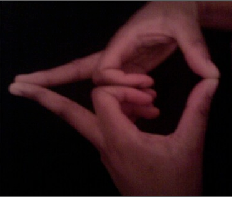
How Are Mudras Practiced?
Mudras can be done while seated, lying down, standing, and walking. Be sure that your body posture is symmetrical and centered, and that you are as relaxed and loose as possible. If you sit on a chair while doing them, your back should be straight and your feet should have good contact with the floor. If you do them while lying down, resting on your back is naturally the most suitable position. If you stay in this position for a long period of time, put a small pillow beneath the back of your head to take the strain off the neck. To relieve your back, you can put a cushion under the hollow of the knee or thigh. It is important to remain comfortable and relaxed, for any tension will also hinder the inner flow of energy and we want something new to flow with the mudras. If you do them while walking, make sure you move in an even, calm, and rhythmic way. If you stand while doing them, keep your legs shoulder distance apart. The knees should be relaxed, and the tips of the toes must point forward.
If you have a bit more time, you can also do the mudras in a seated meditation position—this will turn them into a longer period of meditation. When you do this, take into consideration the following basic principles of meditation technique:
✓ Sit with an upright pelvis and a straight spinal column on a stable cushion. Both knees should be flat on the ground or at the same height (if necessary, support the lower knee with a cushion until it is at the same height as the other knee).
✓ Let the hands relax on the thighs.
✓ Let the shoulders fall back and down in a relaxed way; your chest should be open and free.
✓ Pull the chin back a bit, and let the neck be long and relaxed.
✓ Breathe in an even, slow, flowing, and gentle way.
✓
Never end the meditation suddenly. Always vigorously stretch your arms and legs.
You can also form a mudra and think of something else at the same time. However, I have found that the effect is accelerated and intensified when you simultaneously assume a meditative position, focus on your hands, and observe your breathing. Observing the normal flow of the breath or influencing and directing the breath is a very important way of supporting the mudra. How to do this is explained for the individual mudras. Corresponding visualizations and affirmations can be used so that this never becomes just a routine matter. These also intensify the effects of the mudras. For some exercises, I am no longer certain what has the greatest effect—the mudra, the breathing technique, the visualized image, or the spoken word.

